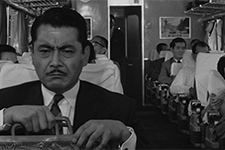High and Low (Tengoku to jigoku) (4K UHD)
|  Following his breakthrough success with Rashomon in 1950, the film that literally opened the rest of the world’s eyes to Japanese cinema, Akira Kurosawa spent most of the next two decades making jida-geki, or dramatic films set in the past, which included his long string of samurai films such as Seven Samurai (Shichinin no samurai, 1954) and Yojimbo (1961). However, throughout this period he also made a handful of gendai-geki—dramatic films set in contemporary Japan. In each of these, Kurosawa explored pertinent moral and social issues, including what it means to live in Ikiru (1952), the fear of nuclear annihilation in I Live in Fear (Ikimono no kiroku, 1955), and corporate malfeasance in The Bad Sleep Well (Warui yatsu hodo yoku nemuru, 1958). While High and Low (Tengoku to jigoku) fits in neatly with those other films, it also stands out in that it is first and foremost an expertly crafted mystery thriller whose story of a kidnapping and its aftermath is woven through with a particularly acute portrait of the decay of modern Japan. The idea of morality and honor under fire in postwar Japanese society was a constant in Kurosawa’s gendai-geki films, but never had it been quite so vile and chaotic as we see here, especially in the film’s final third, which takes place primarily in the slums of Yokohama with its pop music clubs, flop houses, and alleyways filled with heroin addicts. Kurosawa had done something similar in Stray Dog (Nora inu, 1949), a police procedural that was as much about the sordid nature of the postwar criminal underworld as it was about its central mystery, but in High and Low the social dimension takes on an even stronger and tighter fever pitch. Interestingly, the film was adapted from King’s Ransom, a 1959 novel in the pulpy “87th Precinct” series by Ed McBain (a pseudonym for Evan Hunter), making it the only Kurosawa film explicitly based on an American book. In the second-to-last of his 16 collaborations with Kurosawa, Toshirô Mifune plays Kingo Gondo, a wealthy industrialist who has made his fortune running the factories of the National Shoe Corporation. In the film’s opening sequence, he rebukes an offer from three corporate executives who want him to join them in a buy-out, not because he doesn’t desire control of the company, but because he is disgusted by their narrow and greedy profit-over-quality mentality. Gondo may be wealthy (which is visualized in his modernist mansion on a bluff that overlooks the much poorer neighborhoods below), but he has earned his riches by working his way up the ladder and never capitulating to easy money over solid craftsmanship. In other words, there is honor in what he does, even if it is misunderstood by those lower on the socioeconomic ladder. The story proper is set in motion when Gondo receives a phone call demanding a ransom of 30 million yen to return his kidnapped son. Paying the ransom will effectively ruin him because he has mortgaged everything he owns in a bid to gain control of National Shoe. As it turns out, it is not his son who has been kidnapped, but rather his meek chauffeur’s, but no matter; the kidnapper demands the money anyway or else he will kill the boy. Thus, Gondo is immediately thrust into a prickly moral situation: If he pays the ransom for another man’s child, he will be financially ruined; if he doesn’t, he will quite possibly have blood on his hands. In essence, the film sets up the same question that was at the heart of Ikiru, except in more direct, literal terms: What is a human life worth? As a thriller, High and Low is fascinating in the way it is structured into three distinct acts, each of which shifts focus to a different character and creates a unique form of tension and suspense. The first act, in which the child is kidnapped, gnaws at our nerves with questions of how the kidnapping will go down. Will Gondo capitulate and pay? If so, will the boy be released safely? Will the switch go down according to plan, or is there a betrayal afoot? That act then naturally bleeds over to the question of who the kidnapper(s) are and whether or not they will be caught. There are many possible suspects, including the National Shoe executives, who would benefit from Gondo’s financial ruin, and Kawanishi (Tatsuya Mihashi), Gondo’s secretary who ends up betraying him in favor of ensuring his own financial stability. At this point in the film, Gondo becomes a secondary character and the police force, embodied primarily by Chief Detective Tokura (Tatsuya Nakadai), steps to the fore, diligently working through the evidence and following up on every possible lead. It is in this second act that Kurosawa throws us for a loop by showing us the kidnapper, albeit not in much detail, well before the police know his identity. Thus, while we have seen his face, we don’t know who he is. The third act, then, hinges on the question of motive. Once the kidnapper has been identified, the police sit back and set up a trap to ensure that he is put away with the maximum penalty, but our minds are reeling with the question of “Why?” Who is this person and what is the motivation for such a carefully plotted and purposefully cruel crime? Having seen Gondo as an essentially decent man (he is most explicitly humanized when we see him, financially destroyed, maintaining his dignity by mowing his yard in the sweltering heat), it is hard to imagine who would despise him so thoroughly. Yet, when we see Gondo’s home from different perspectives, high atop the hill like a fortified castle, it is not hard to understand what he might represent to those less fortunate. And this, ultimately, is what High and Low is really about. The film’s thriller elements are honed to a razor-sharp edge and work to draw you deep into the characters’ various dilemmas, but as its title suggests, society’s gaps between the have’s and the have-not’s is the film’s primary subject. The literal meaning of the Japanese title Tengoku to jigoku is Heaven and Hell, which suggests just how vast Kurosawa sees the gap between the privileged and the suffering. However, the fact that Gondo, the film’s chief representative of the privileged elite, is an honorable and decent man who earned his position with hard work and honesty and literally sacrifices everything for someone else suggests that Kurosawa is not seeing in black and white terms. He certainly gives us extremes on both ends (the self-serving National Shoe executives on one end and a writhing, pathetic mass of junkies on the other), but High and Low sticks to your gut as social commentary because it shows us the vast expanse of gray in-between.
Copyright © 2025 James Kendrick Thoughts? E-mail James Kendrick All images copyright © The Criterion Collection | |||||||||||||||||||||||||||||
Overall Rating: 


 (4)
(4)


